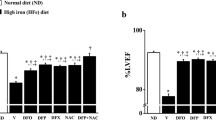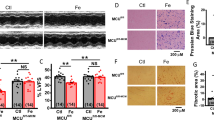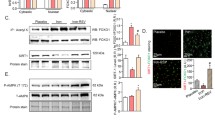Abstract
It is thought that aging in rats and humans is associated with increases in iron accumulation and cell apoptosis. Here, we examine the relationship between cardiac iron levels and apoptosis in aged F344XBN rats that had been treated with an oral iron chelator (Deferasirox; 100 mg/kg body weight) on alternate days for 6 months. Compared to adult animals (6 month), cardiac iron (+72%), liver iron (+87%), ferritin light chain (+59%), divalent metal transporter-1 (+56%) and the number of TdT-mediated dUTP nick end labeling (TUNEL) positive cells (4.3 fold increase) were higher in 33-month-old animals (P < 0.05). Deferasirox treatment decreased cardiac iron levels by 37% (P < 0.05), and this was associated with decreases in the number of TUNEL-positive cells. Age-associated increases in cell death were coupled with increases in Bax to Bcl-2 ratio, and the amount of Bad, full-length caspase-3, and cleaved caspase-3. Deferasirox treatment decreased the Bax to Bcl-2 ratio by 17% (P < 0.05) and the amount of Bad, full-length caspase-3, cleaved caspase-3 (19 kDa), and cleaved caspase-3 (17 kDa) by 41, 16, 22, and 37%, respectively (P < 0.05). Taken together, these data suggest that deferasirox may be effective in diminishing age-associated iron accumulation and cardiac apoptosis in the F344XBN rat model.






Similar content being viewed by others
References
Lakatta, E. (1994). Aging effects on the vasculature in health: Risk factors for cardiovascular disease. The American Journal of Geriatric Cardiology, 3, 11–17.
Laurent, S. (1995). Arterial wall hypertrophy and stiffness in essential hypertensive patients. Hypertension, 26, 355–362.
Menon, B., Johnson, J. N., Ross, R. S., Singh, M., & Singh, K. (2007). Glycogen synthase kinase-3beta plays a pro-apoptotic role in beta-adrenergic receptor-stimulated apoptosis in adult rat ventricular myocytes: Role of beta1 integrins. Journal of Molecular and Cellular Cardiology, 42, 653–661.
Muscari, C., Giaccari, A., Giordano, E., Clo, C., Guarnieri, C., & Caldarera, C. M. (1996). Role of reactive oxygen species in cardiovascular aging. Molecular and Cellular Biochemistry, 160–161, 159–166.
Harman, D. (2003). The free radical theory of aging. Antioxidants & Redox Signaling, 5, 557–561.
Baskin, S. I., Kuhar, K. P., Uricchio, F. J., & Harper, G. R. (1981). The effect of age on five ions of the kidney in the Fischer 344 rat. Reproduction, Nutrition, Development, 21, 689–694.
Cook, C. I., & Yu, B. P. (1998). Iron accumulation in aging: Modulation by dietary restriction. Mechanisms of Ageing and Development, 102, 1–13.
Killilea, D. W., Atamna, H., Liao, C., & Ames, B. N. (2003). Iron accumulation during cellular senescence in human fibroblasts in vitro. Antioxidants & Redox Signaling, 5, 507–516.
Killilea, D. W., Wong, S. L., Cahaya, H. S., Atamna, H., & Ames, B. N. (2004). Iron accumulation during cellular senescence. Annals of the New York Academy of Sciences, 1019, 365–367.
Hahalis, G., Alexopoulos, D., Kremastinos, D. T., & Zoumbos, N. C. (2005). Heart failure in beta-thalassemia syndromes: A decade of progress. The American Journal of Medicine, 118, 957–967.
Kalinowski, D. S., & Richardson, D. R. (2005). The evolution of iron chelators for the treatment of iron overload disease and cancer. Pharmacological Reviews, 57, 547–583.
Richardson, D. R. (2005). Molecular mechanisms of iron uptake by cells and the use of iron chelators for the treatment of cancer. Current Medicinal Chemistry, 12, 2711–2729.
Asano, S., Rice, K. M., Kakarla, S., Katta, A., Desai, D. H., Walker, E. M., et al. (2007). Aging influences multiple indices of oxidative stress in the heart of the Fischer 344/NNia x Brown Norway/BiNia rat. Redox Report, 12, 167–180.
Hacker, T. A., McKiernan, S. H., Douglas, P. S., Wanagat, J., & Aiken, J. M. (2006). Age-related changes in cardiac structure and function in Fischer 344 x Brown Norway hybrid rats. American Journal of Physiology. Heart and Circulatory Physiology, 290, H304–H311.
Rice, K. M., Preston, D. L., Walker, E. M., & Blough, E. R. (2006). Aging influences multiple incidices of oxidative stress in the aortic media of the Fischer 344/NNiaxBrown Norway/BiNia rat. Free Radical Research, 40, 185–197.
Walker, E. M., Jr., Nillas, M. S., Mangiarua, E. I., Cansino, S., Morrison, R. G., Perdue, R. R., et al. (2006). Age-associated changes in hearts of male Fischer 344/Brown Norway F1 rats. Annals Clinical and Laboratory Science, 36, 427–438.
Wood, J. C., Otto-Duessel, M., Gonzalez, I., Aguilar, M. I., Shimada, H., Nick, H., et al. (2006). Deferasirox and deferiprone remove cardiac iron in the iron-overloaded gerbil. Translational Research, 148, 272–280.
Drexler, E., Slifka, A., Wright, J., McCowan, C., Finch, D., Quinn, T., et al. (2003). An experimental method for measuring mechanical properties of rat pulmonary arteries verified with latex. Journal of Research of the National Institute of Standards and Technology, 108, 183–191.
Walker, E. M., Jr., Epling, C. P., Parris, C., Cansino, S., Ghosh, P., Desai, D. H., et al. (2007). Acetaminophen protects against iron-induced cardiac damage in gerbils. Annals of Clinical and Laboratory Science, 37, 22–33.
Towbin, H., Staehelin, T., & Gordon, J. (1979). Electrophoretic transfer of proteins from polyacrylamide gels to nitrocellulose sheets: Procedure and some applications. Proceedings of the National Academy of Sciences of the United States of America, 76, 4350–4354.
Gupte, A. A., Bomhoff, G. L., & Geiger, P. C. (2008). Age-related differences in skeletal muscle insulin signaling: The role of stress kinases and heat shock proteins. Journal of Applied Physiology, 105, 839–848.
Wheeler, M. T., Zarnegar, S., & McNally, E. M. (2002). Zeta-sarcoglycan, a novel component of the sarcoglycan complex, is reduced in muscular dystrophy. Human Molecular Genetics, 11, 2147–2154.
Hussein, M. R., Haemel, A. K., & Wood, G. S. (2003). Apoptosis and melanoma: Molecular mechanisms. Journal of Pathology, 199, 275–288.
Puntarulo, S. (2005). Iron, oxidative stress and human health. Molecular Aspects of Medicine, 26, 299–312.
Kevin, L. G., Novalija, E., & Stowe, D. F. (2005). Reactive oxygen species as mediators of cardiac injury and protection: The relevance to anesthesia practice. Anesthesia and Analgesia, 101, 1275–1287.
Atamna, H. (2004). Heme, iron, and the mitochondrial decay of ageing. Ageing Research Reviews, 3, 303–318.
Jung, S. H., DeRuisseau, L. R., Kavazis, A. N., & DeRuisseau, K. C. (2008). Plantaris muscle of aged rats demonstrates iron accumulation and altered expression of iron regulation proteins. Experimental Physiology, 93, 407–414.
Sullivan, J. L. (1989). The iron paradigm of ischemic heart disease. American Heart Journal, 117, 1177–1188.
Taher, A., Musallam, K. M., El Rassi, F., Duca, L., Inati, A., Koussa, S., et al. (2009). Levels of non-transferrin-bound iron as an index of iron overload in patients with thalassaemia intermedia. British Journal of Haematology, 146, 569–572.
Sherman, A. R., Helyar, L., & Wolinsky, I. (1985). Effects of dietary protein concentration on trace minerals in rat tissues at different ages. Journal of Nutrition, 115, 607–614.
Kakhlon, O., & Cabantchik, Z. I. (2002). The labile iron pool: Characterization, measurement, and participation in cellular processes(1). Free Radical Biology and Medicine, 33, 1037–1046.
Dallman, P. R. (1986). Biochemical basis for the manifestations of iron deficiency. Annual Review of Nutrition, 6, 13–40.
Roth, J. A., Horbinski, C., Feng, L., Dolan, K. G., Higgins, D., & Garrick, M. D. (2000). Differential localization of divalent metal transporter 1 with and without iron response element in rat PC12 and sympathetic neuronal cells. Journal of Neuroscience, 20, 7595–7601.
Ponka, P., Beaumont, C., & Richardson, D. R. (1998). Function and regulation of transferrin and ferritin. Seminars in Hematology, 35, 35–54.
Sprott, R. L. (1991). Development of animal models of aging at the National Institute of Aging. Neurobiology of Aging, 12, 635–638.
Bernecker, O. Y., Huq, F., Heist, E. K., Podesser, B. K., & Hajjar, R. J. (2003). Apoptosis in heart failure and the senescent heart. Cardiovascular Toxicology, 3, 183–190.
Phaneuf, S., & Leeuwenburgh, C. (2001). Apoptosis and exercise. Medicine and Science in Sports and Exercise, 33, 393–396.
Wahr, P. A., Michele, D. E., & Metzger, J. M. (2000). Effects of aging on single cardiac myocyte function in Fischer 344 x Brown Norway rats. American Journal of Physiology. Heart and Circulatory Physiology, 279, H559–H565.
Oltvai, Z. N., Milliman, C. L., & Korsmeyer, S. J. (1993). Bcl-2 heterodimerizes in vivo with a conserved homolog, Bax, that accelerates programmed cell death. Cell, 74, 609–619.
Hengartner, M. O. (2000). The biochemistry of apoptosis. Nature, 407, 770–776.
Thornberry, N. A., & Lazebnik, Y. (1998). Caspases: Enemies within. Science, 281, 1312–1316.
Acknowledgments
This study was supported by funding from Novartis Pharmaceutical to E. R. B.
Author information
Authors and Affiliations
Corresponding author
Rights and permissions
About this article
Cite this article
Arvapalli, R.K., Paturi, S., Laurino, J.P. et al. Deferasirox Decreases Age-Associated Iron Accumulation in the Aging F344XBN Rat Heart and Liver. Cardiovasc Toxicol 10, 108–116 (2010). https://doi.org/10.1007/s12012-010-9068-9
Published:
Issue Date:
DOI: https://doi.org/10.1007/s12012-010-9068-9




